Stonehenge
Phases of Construction
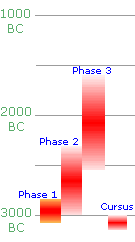
"If we take the history of the oldest cathedral in Christendom, and double it, we are still a thousand years short of the time Stonehenge took to evolve"
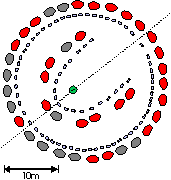
Stonehenge was built over a long period. If we confine ourselves to the stones the work spanned seventy generations - some 1600 years. But we are as far removed from the first stone works at Stonehenge, as those Neolithic masons of 3000 BC were themselves distant from the first people who raised a symbolic structure in the vicinity. True, these first artefacts were just wooden poles which have long gone, but these were raised by men in times so ancient that the glaciers were still releasing the Scottish Highlands from their icy grip. The timeline on the left shows this history, with a frenzy of activity from just before 3000BC through to1600BC being responsible for most of what we now gaze upon in awe.
Construction took place in several phases over more than a thousand years. Later builders occasionally reversed the results of previous efforts, sometimes reusing the fruit of their labour. Few guesses as to its purpose have yielded fruit, but some alignments with solar and lunar phenomena can be observed, and these are most likely intentional. The midsummer sunrise lies very close to the axis between the Heel stone and the centre of the circle, though since this alignment is not exact some dispute its significance.
More accurately aligned are fifty-three postholes across the entrance in 11 rows by six are lined up with the extreme midwinter risings of the moon which would indicate meticulous observation. Another pertinent fact is that the latitude of Stonehenge is remarkable in that the extreme northern and southern rising and setting of the sun and the moon are at right angles to earth other. This neat alignment would be changed by moving the monument only a few miles north or south.
Exact dates are not possible, since dates are inferred from minute changes in physical measurements, such as the radiocarbon-14 dating method. Nevertheless archaeologists have sketched out the following outline of events-
This animation shows the development of the circle over the years, from a simple henge to the glorious lintelled edifice which we now know as Stonehenge.
(it does not show the totem pole stage)
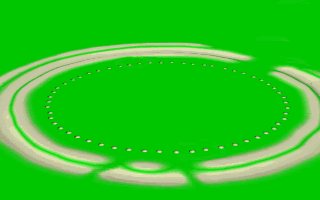
Stonehenge through the years (animation)
The "Totem Poles"
The people of the Mesolithic period who erected the pine posts near Stonehenge are unlikely to have known of the grand vision which was to come. Nevertheless, they erected three huge pine posts in the great pine forest that covered the site at the time. The 1960's car park is built over these - the large round discs you can see in the car park are the modern markers for these 10,000 year old holes...

Stonehenge 1 - the ditch and bank is constructed
Stonehenge 1 will have looked something like this when the bank was first dug - the white chalk strikingly brilliant against the vegetation. The purpose of the 56 'Aubrey holes' which date from this time is unknown. They held no stones, but it is possible that they held wooden posts, now rotted away.
Note that the ditch is bridged at the North-East (the view is standing at the South looking due North). This is along the general direction of the midsummer sun, and several rows of wooden posts were placed in this causeway. They may have been sightlines for observations - though they may also been simple guiding channels for people going into the centre
Stonehenge Phase I
The Great Cursus less than 1km from Stonehenge had been constructed - nearly 2.8 km long and 150 m wide, this was a ditch hewn in the chalk a couple of metres deep and wide. This will have appeared brilliant white in the green of what had now become pastureland. The hunter-gatherers of the "totem poles" had given way to farmers, who stayed long enough in one region to construct large earthworks.
At the Stonehenge site, the henge(the earthworks ditch and bank) is constructed. A ditch about 2m deep was dug, with picks made of deer antlers. The spoil from the ditch made the bank on the inside. On the northeast a gap in the ditch and bank makes the entrance.
Many visitors to Stonehenge fail to notice the 'henge' since the ditch and bank have been greatly eroded over the passing millennia. It is worth looking for - though slight it is visible.
Just inside the bank, the Aubrey holes - a circle of fifty-six pits are dug. These were almost immediately filled in again and their purpose is not known.
The Heel stone is setup at the entrance, there is evidence of another stone near the Heel stone at this time.
Stonehenge Phase II
c 2500 to c 2700 BC
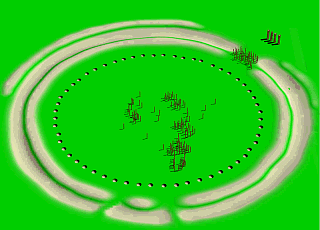
Stonehenge Phase 2 - wooden poles
A large number of wooden posts were on the site during this time. The ones at the north-eastern entrance may have served as markers for astronomical measurements, in particular the extremes of the moonrise/set. Other scholars feel these may have guided people through narrow paths to the ceremonial centre, adding a mystique to the entry.
Wood does not preserve well over the millennia so the picture of this phase is unclear. In particular, the jumble you see in the diagram could be the result of many different construction stages all overlaid - the model has simply placed posts in most of the recorded stakeholes. They do not need to all have been up at the same time.
With a little extrapolation, it is possible to make out the outline of perhaps a round structure in the centre of the circle, and there does appear to be a passageway leading out from the southern entrance (at the bottom of the circle in this picture)
Any fragments of wood that are found are organic and therefore the radiocarbon dating method can be applied to them
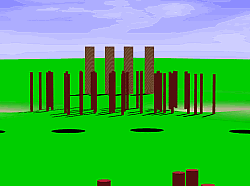
view from the centre through the NE entrance poles
When looked at from the centre of the monument, we can see that the entrance stakes line up - these small posts are six rows deep. The four larger posts furthest away are located in what was later to become the Avenue leading to the northeast. They were perhaps 1m in diameter, possibly whole tree trunks. It is possible that there is evidence of more of them since excavation did not cover a large area.
Stonehenge Phase IIIa
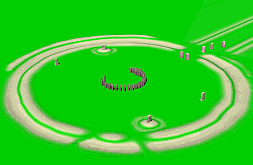
Stonehenge Phase 3
Stones begin to arrive in phase 3 - first the bluestones, imported all the way from Wales for reasons still unknown to us. The Avenue was begun, the four Station Stones (seen here just inside the bank) were raised and the bluestones placed in the arrangement shown. The tall Altar Stone which was later to feature in the Sarsen ring made its appearance in this early stage.
This horseshoe of bluestones arrange in pairs is an enigmatic period of Stonehenge. It was short-lived, even though it must have taken a phenomenal amount of work to raise.
On theclose-up diagram, you can see the tall Altar stone just before the horseshoe ends closest to the viewer.
Opposite that and aligned with the stones at the north-eastern entrance and Avenue the stones become triples and quads instead of doubles. Again the alignment of the SW - NE is significant.
Modern viewers will begin to recognise this - the characteristic Sarsen lintelled circle 30m in diameter. The bluestones are yet to be brought back to the circle
Stonehenge Phase IIIb
c 2300 -2400 BC
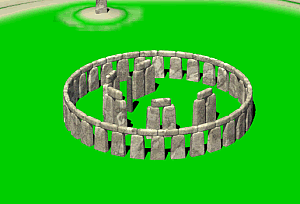
Stonehenge Phase 3b
Stonehenge Phase IIIc
c 2200 to c 1800 BC
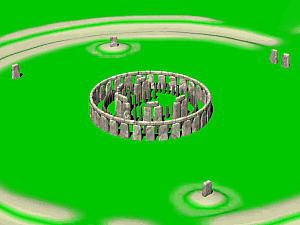
Stonehenge Phase 3c
After this stage, two concentric circles of pits were dug outside the sarsen circle, the Y and Z holes, thirty of each lining up with the sarsens. They are imprecisely marked out, and stones were never placed in these holes, though we can imagine that another two rings of stones outside the sarsens was conceived. Whatever the plans, this stage was never implemented.
Stonehenge in its final splendour - a continuous ring of sarsen elevated in the air, the first and the only raised stone circle known. Around 1100 BC the Avenue is lengthened for another 1 1/2 miles out to the river Avon at Amesbury.
It goes unmentioned in historical records for two thousand years, until in 1130 Henry of Huntingdon became the first person whose written account survives
"Stanenges, where stones of wonderful size have been erected after the manner of doorway, so that doorway appears to have been raised upon doorway; and no one can conceive how such great stones have been raised aloft, or why they were built there"